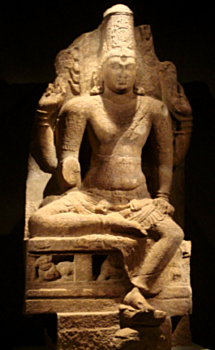 Mara Varman Sundara Pandya I was the brother of Jata Varman Kulasekhara, who ruled the kingdom of Pandyas from 1216 AD - 1238 AD. He revived the power of the Pandya dynasty which lasted through the thirteenth century. During the starting years of his rule he invaded the kingdom of Kulottunga Chola III, and burned Uraiyur and Tanjore. As the Hoysalas had intervened he had to give back the territories he had invaded. Before him ascending the throne the Pandyas were the Chola vassals.
Mara Varman Sundara Pandya I was the brother of Jata Varman Kulasekhara, who ruled the kingdom of Pandyas from 1216 AD - 1238 AD. He revived the power of the Pandya dynasty which lasted through the thirteenth century. During the starting years of his rule he invaded the kingdom of Kulottunga Chola III, and burned Uraiyur and Tanjore. As the Hoysalas had intervened he had to give back the territories he had invaded. Before him ascending the throne the Pandyas were the Chola vassals.
Sundara Pandyan invaded Kulothunga to take revenge of his brother`s humiliation. He dismissed the Chola cities. In commemoration of this victory he performed a virabhisheka in Tanjore district. However the Cholas had to accept his supremacy. This incident marked the beginning of the restoration of Pandyan power. In 1225 AD he drove the Oriya soldiers who had attacked Srirangam. He formed an alliance with Kadava chief Kopperunchingan I to fight against Cholas and Hoysalas. Mara Varman defeated Rajaraja Chola III, and occupied large parts of Chola Empire. He had also along with his forces marched to Chidambaram and celebrated his victories there too. The Hoysalas interfered here and defeated the Pandyas, invaded their kingdom. The Hoysala ruler Narasimha II defeated him on the banks of the River Kaveri in 1231 AD. After this defeat peace was made between the four ruling dynasties of south through dynastic marriages. Thus Mara Varman`s victories against the Cholas were futile. His victories over Cholas have been mentioned in the Thirukkolur inscription.
He had assumed titles like Kaliyugaraman and Adisayapandiyadevan. The coins he had issued also had the title of sonadugondan meaning conqueror of Chola country. He was succeeded by Mara Varman Sundara Pandya II in 1238 AD.



















